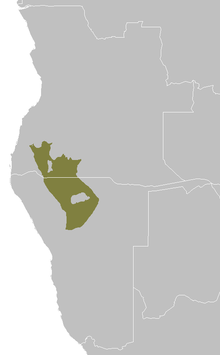The violet wood hoopoe (Phoeniculus damarensis) is a species of bird in the family Phoeniculidae. It is found in Angola, Kenya, Namibia, and Tanzania. It looks similar to the black-billed wood hoopoe but with a red beak and a green throat. It has coppery and violet mantle feathers.[2]
| Violet wood hoopoe | |
|---|---|

| |
| Illustration (above) with black-billed wood hoopoe (below) | |
| Scientific classification | |
| Domain: | Eukaryota |
| Kingdom: | Animalia |
| Phylum: | Chordata |
| Class: | Aves |
| Order: | Bucerotiformes |
| Family: | Phoeniculidae |
| Genus: | Phoeniculus |
| Species: | P. damarensis
|
| Binomial name | |
| Phoeniculus damarensis (Ogilvie-Grant, 1901)
| |

| |
| General range: the Angolan mopane woodlands | |
Taxonomy
editGrant's wood hoopoe (P. d. granti) is sometimes considered a full species. Due to genetic similarities in mitochondrial DNA analysis between the violet woodhoopoe and the green woodhoopoe, some believe the violet woodhoopoe is not a separate species from the green woodhoopoe.[3] However, some scholars suggest the violet woodhoopoe is indeed its own species, based on different foraging patterns attributed to its more terrestrial foraging juxtaposed to the green woodhoopoe's arboreal foraging.[4]
References
edit- ^ BirdLife International (2016). "Phoeniculus damarensis". IUCN Red List of Threatened Species. 2016: e.T22682673A92955974. doi:10.2305/IUCN.UK.2016-3.RLTS.T22682673A92955974.en. Retrieved 12 November 2021.
- ^ Cooper, Mark; Sewell, Brian; Jaffer, Mohamed (2019-03-20). "Iridescence of Violet Woodhoopoe Mantle Feathers". Biodiversity Observations. 10. doi:10.15641/bo.v10i0.504. ISSN 2219-0341.
- ^ Cooper, Mark I.; Cunningham, Michael; Cherry, Michael I. (July 2001). "Taxonomic status of the Namibian Violet Woodhoopoe Phoeniculus damarensis as determined by mitochondrial DNA". Ibis. 143 (3): 572–579. doi:10.1111/j.1474-919X.2001.tb04884.x.
- ^ du Plessis, Morné A; Simmons, Robert E; Radford, Andrew N (March 2007). "Behavioural ecology of the Namibian Violet Woodhoopoe Phoeniculus damarensis". Ostrich. 78 (1): 1–5. doi:10.2989/OSTRICH.2007.78.1.1.45.
External links
edit- Violet wood hoopoe - Species text in The Atlas of Southern African Birds.
